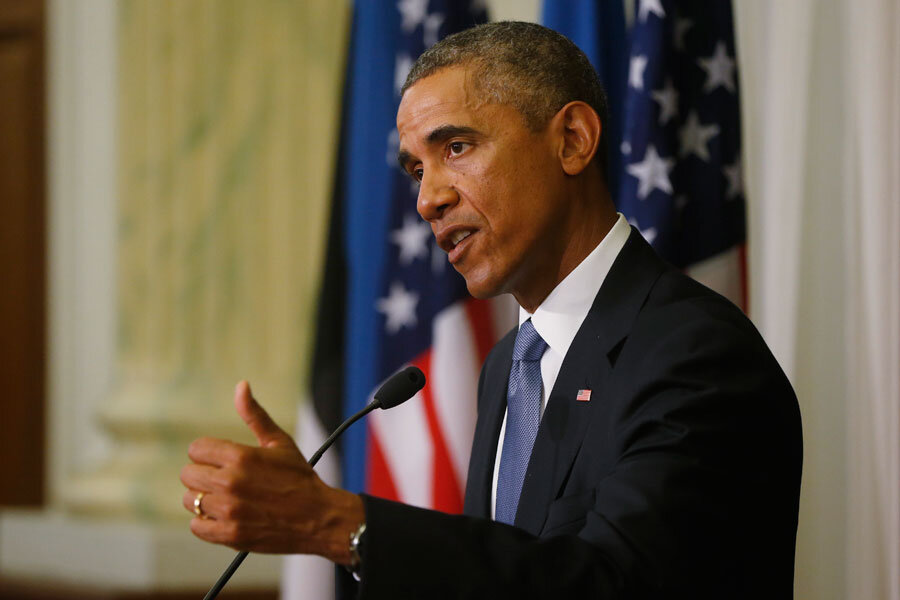Did Obama just turn up the heat on the Islamic State?
Loading...
| United Nations, N.Y.
The second videotaped beheading of an American journalist by the Islamic State has prompted a hardening of President Obama’s rhetoric and a clarity of purpose concerning American intentions toward the Islamist extremist group – something a growing and bipartisan chorus of critics was declaring absent from the US response.
“Our objective is clear, and that is: degrade and destroy ISIL so that it’s no longer a threat, not just to Iraq but also to the region and to the United States,” Mr. Obama said Wednesday, using the acronym the administration prefers for the Islamic State (IS), which is also known as ISIS.
The president’s comments, delivered at a press conference in Talinn, Estonia, followed an announcement that US intelligence had verified the authenticity of a video released Tuesday showing the beheading of American Steven Sotloff.
The video included a direct challenge to the president, with a British-accented executioner blaming “arrogant” US foreign policy against IS for the group’s retaliation. The speaker appeared to be the same masked individual, dagger in hand, who killed journalist James Foley on tape last month.
“I’m back, Obama, and I’m back because of your arrogant foreign policy towards the Islamic State, because of your insistence on continuing your bombings and [strikes] on Mosul Dam, despite our serious warnings,” the robed figure states, a kneeling Mr. Sotloff at his side.
Obama’s statement – notably including the pledge to “destroy” the extremist group – was in sharp contrast to the president’s much-maligned observation last Thursday that “we don’t have a strategy yet” for dealing with IS.
Some foreign-policy analysts had said that Secretary of State John Kerry was out in front of the president’s policy toward IS when he said last month that the US objective was to “destroy” IS.
Administration officials said later that the president meant he was still considering “options” for addressing the extremist group in Syria. IS is most firmly rooted in Syria and controls a section of northeastern Syria it won in fighting the regime of Syrian President Bashar al-Assad.
But critics said the statement laid bare Obama’s lack of a strategy toward Syria – after more than three years of a region-destabilizing civil war – as well as the consequences of his strong reluctance to involve the US in the conflict.
In his comments Wednesday, delivered on the eve of a NATO summit in Wales, Obama laid out a two-stage plan for addressing the IS threat.
The first objective would be “blunting the momentum” of the group in Iraq, where IS fighters from neighboring Syria overwhelmed Iraqi security forces and took control of major cities and oil fields.
Indeed, Obama claimed the “blunting” of the group’s momentum had been accomplished, saying, “The airstrikes have done that.”
Obama ordered airstrikes on IS positions in Iraq last month when the group advanced on the Iraqi Kurdish region, where the US has a consulate and a large number of personnel, and threatened to wipe out the Yezidi religious minority population.
The US airstrikes have continued to take out IS positions and equipment in Iraq and are credited with easing the militants’ threat to Mosul Dam, Iraq’s largest.
But Obama said a second stage would require developing a “regional strategy” that will involve enlisting regional partners to take the fight to IS both “in the air and on the ground.” Obama has ordered Secretary Kerry to travel to the Middle East following the NATO summit to begin building the coalition the president wants to enlist in the battle with IS.
Sotloff’s killer makes it clear in Tuesday’s video that he is aware of Obama’s plans to form a regional coalition, and he suggests that any government signing up can expect to face reprisals. “We take this opportunity to warn those governments that enter this evil alliance of America against the Islamic State to back off and leave our people alone,” he says.
Obama, who has established himself as a cautious realist, particularly in the foreign-policy field, also appeared to be seeking dampen any expectations that IS could be dealt with quickly or easily destroyed.
“This is not a one-week or one-month or six-month proposition,” he said Wednesday. Saying it will “take time to roll them back,” Obama also seemed ultimately to hedge on his objective to “destroy” IS.
Comparing the group to Al Qaeda, he said, “There’s always going to be remnants that can cause havoc.”






